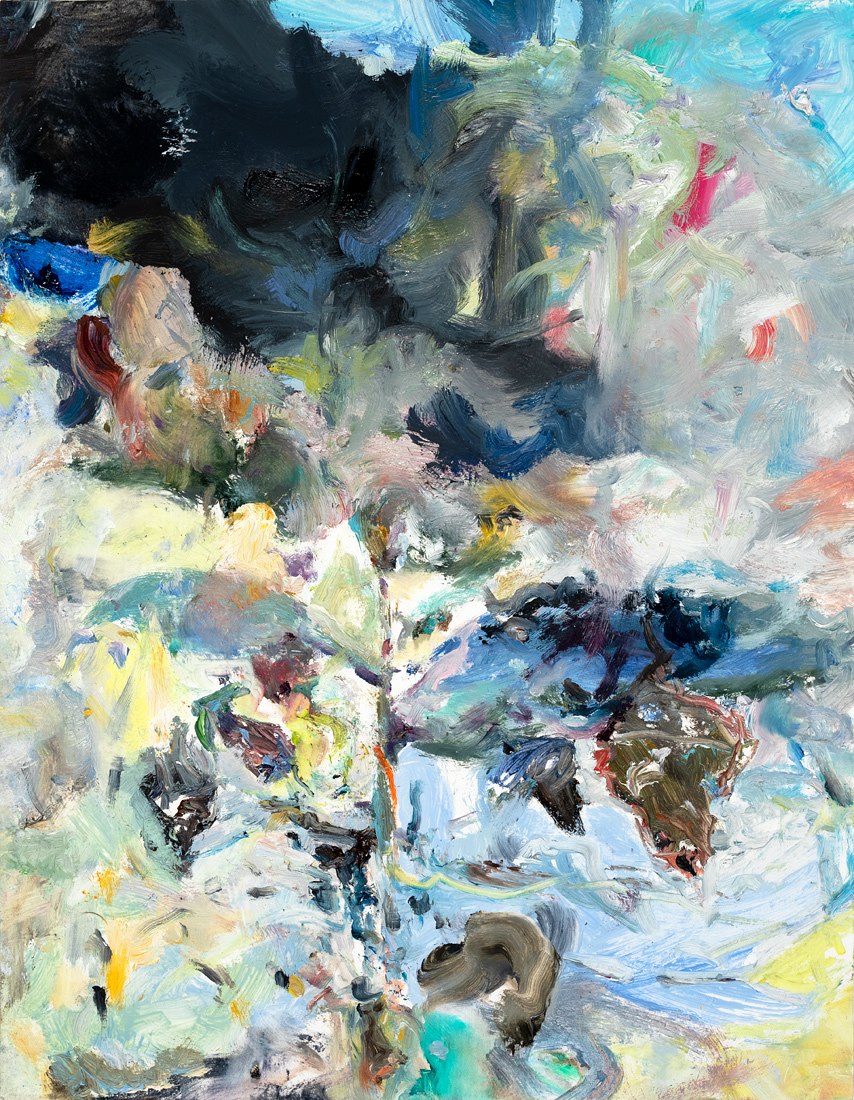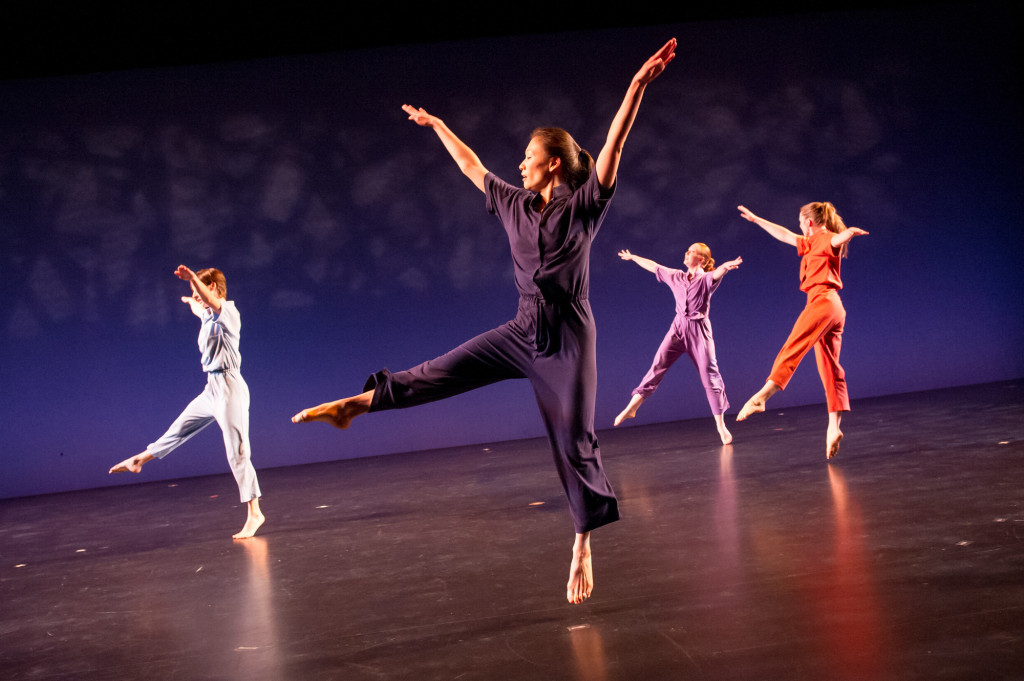That’s what I was wondering, as a visual artist myself, wondering about the differences between that and what you do. How do you make work? What’s your working process? How do you self-edit?
Well it’s really different for each piece. It’s hard to know exactly what the working process for that piece was because it was so many years ago. But I doubt it would be too much different from now. The way I work now and have for as long as I’ve been aware of how I’m working is that I start making phrases of movement, and they get written down. And they get memorized and uncannily enough I almost always work chronologically, it starts at the beginning and just goes. I rarely start with music, music comes often quite a bit later. I start with my own forms of rhythmic structuring. In Energizer, it’s just a real solid base of 4/4 all the way through. Dances made after that would be rhythmically all over the place, you know, a measure of 5, a measure of 7, like the piece I did in 1983 called Hemispheres with Anthony Davis was really polymetric, so that formatting changed. I’m pretty sure at that time, in 1980, I would have dancers come in probably maybe an hour or two after I’d been working by myself and then I’d teach them what I’d made, and then I would set it spatially. For Energizer I was really interested in a circle, and then within that there’s the square of the axis, so there’s this sort of pie thing going on—there’s the top axis, the horizontal axis, the vertical axis and then the diagonal axes, and there’s a sense that a rotational idea is going on, and then there’s also a big square around the whole thing, so there’s an outer perimeter square and then an inner circle. It gets cut up and re-seen over and over—a dancer will do something and then another dancer comes immediately and does the same pathway but then maybe has a different ending and goes off and does something else, and then that might be echoed by another dancer. So it’s very intricate, moment by moment. And then as I said, I work very intuitively. I’m sure that in Energizer, once I would get something done—and we didn’t have video back then! —you just did stuff, and you either remembered it or you didn’t. Of course the piece was video taped, because that’s how I was able to reconstruct it. The piece that was playing out in the lobby (at New York Live Arts on October 2nd-5th) was the original, that’s the tape that we reconstructed from, so you could see it was really fuzzy, but we managed. As far as daily doings or daily remembering of what we’ve made, it’s all just memorization. It’s writing it down and memorizing, and then the dancers will do the same thing, come in day after day, and you just drill over and over and over and over until it gets completely intact and completely known.
What is it like to work with other dancers? Do you see their bodies and their energies as yours? How do you form other people to make the spatial expressions that you want?
Well I work with people who are really well trained; they have a lot of physical ability. I don’t want them to look exactly like me necessarily, I don’t teach my dancers class every day or something like that. People come to me already warmed up, and either they’re from a ballet background or a Cunningham background—whatever their dance background is, what I take into consideration is the means of how they will translate. And everybody tries very hard to do exactly what I’m doing—I’ll put my hands like that and they do it. But it looks different on everybody because it’s a different body. I really love that. I’m not interested in having everyone look the same, I’m interested in there being a vocabulary that’s translated from person to person in their own idiosyncratic way. In terms of a commonality, we’re all working towards this very particular vocabulary and how to present it in its most clear form from person to person.
What was your first memory of wanting to move through space to express yourself?
Well when I was a little girl I used to make dances for my dog and me. I had a dog named Shadow and I used to dance around the living room with Shadow all the time. I grew up in Nigeria and was always outside, and I saw a lot of Nigerian dance. I just felt really at home in moving my body.
The Energizer piece seemed to really express some of that rawness, that sort of grounded excitement about learning how to work as a dancer. Is that right?
Yes, that’s exactly right. There’s a total exhilaration there. And also you have to understand, I graduated from Mills College in 1975. I was 20, I got on a bus and came here to New York, and my first major piece was in ’77, and then in ’79 The Kitchen commissioned a work. So it was very quick, I just jumped in and started being a choreographer right away. I came from a training that was modern dance—we studied Graham technique, Cunningham technique, and Limon technique. I had one semester of ballet, from a woman named Paulette Sears, who was one of the MFA graduate students. I’m not from a ballet background whatsoever. The movement is coming from my interest in the upper body being a very translational mechanism of communication. I guess you could say it started off referencing Egyptian hieroglyphics that I then I twisted into three dimensions. I started forging this vocabulary on my own.
Can you talk more about growing up in Nigeria and attending high school in Spain? What was that like and what made you decide to come back to the states to go to college?
Well I went to high school in Spain because I wanted to go to an American college and the high schools in Nigeria were not accredited. All the American embassy kids—my Dad worked with USAID— kids from North and West Africa went to high schools in Spain at American air force bases. The first year I was there I was in Sevilla, which is in the south and the second year which was my senior year I was in Zaragosa in the north. On an air force base, which is so-called “American soil” in Spain, we would take weekend trips into the city. I saw a lot of flamenco dance, which I was very influenced by, and although I didn’t study it, I really loved the whole extension of the back and the hands behind the head. There’s a lot of that in my work, particularly in my early work. I really loved the extreme verticality with really flamboyant arms. You know when you’re a kid, you just grow up where you grow up, and you don’t really have an opinion about it. When I got older I realized how lucky I was to have grown up in Nigeria. We were in Ibadan, which is about 90 miles inland of Lagos when we first got there, and then later we moved to Lagos on the coast. Our house in Ibadan was right up next to the bush; my brother and I were always on the bush paths. It was a really magical life, and I think about that now, I just think I was so lucky to have had that kind of nature around me, that deep, dark rainforest. Deep and complex and thick rainforest, beautiful—it was absolutely beautiful.
The earlier work that was restaged for the performance felt like that—it felt really grounded in real stuff, the landscape.
The landscape, there’s also a lot of social dance, dancers coming together a lot in these circles.
You’ve done a lot with props and projections and live feeds, and that’s all in addition to working with other creative people. What was the first inanimate object you put into one of your pieces and why did you decide to go in that direction?
I guess the first one—well you saw in the lobby the video of the piece I made with Keith Haring, that was my first piece. That was 1979, I think. The first object though was by the artist Steve Keister for a piece called Boca Raton at The Kitchen for an event called Dance Day. The piece was a small sculpture attached to the ceiling, that was probably the first object. I didn’t relate to it, except that we were underneath it.
He was a substitute for one of my sculpture classes at SVA, he’s really nice and an interesting artist.
Yeah, I actually know him now; he’s a very good friend of Roy’s. But as far as an object that I dealt with—in 1983 there was a project called Hemispheres and it had a series of drawings by Francesco Clemente. The drawings came in packages of ten and when the audience came in they were handed a package of ten —there were four different sets, so the idea was that you got package A and your friend got B, then the next person got C, and D and so on. So the person sitting next to you if you came in as a pair would get another set. Francesco liked this idea of possible commerce; it was the idea of the set design being actually in your hand rather than on the stage. That was very interesting.









